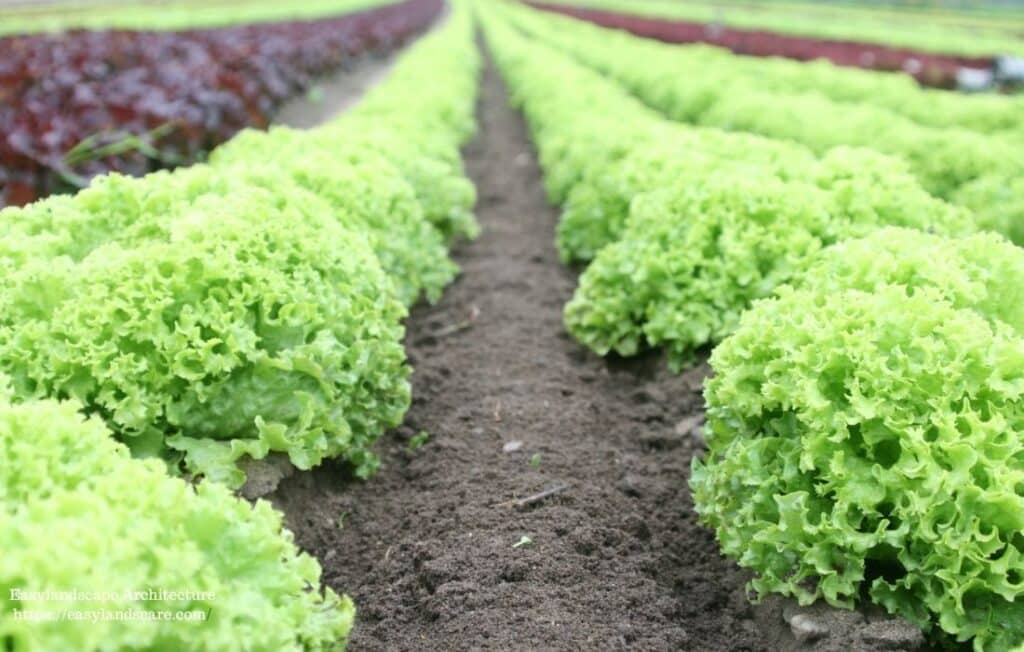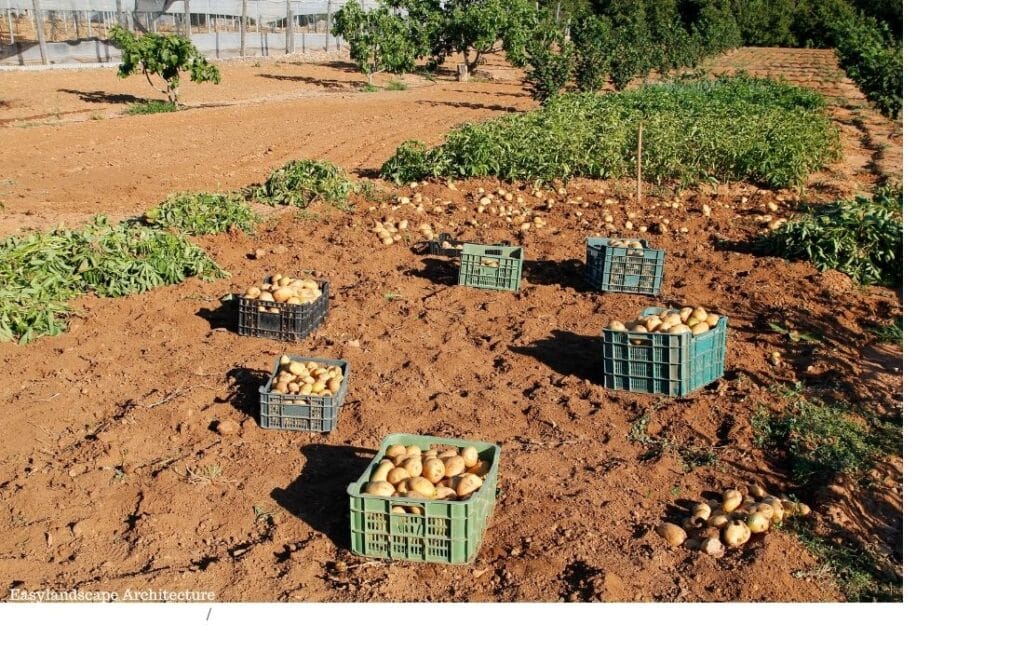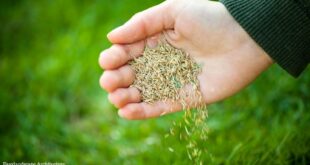Overview of The Row Planting
Row planting, the technique of sowing seeds in straight, parallel lines, has been used for centuries. If farmers still rely on this method today, there must be valid reasons behind it—and that deserves respect.
When you think about it, the logic behind row planting is quite simple. From a harvest perspective, this method offers several advantages:
- Improved harvesting efficiency
- Healthier crop growth
- Time savings
- Most importantly, more effective use of agricultural machinery
Whether you’re a home gardener or a commercial farmer, understanding the principles and evolving techniques of row planting can significantly enhance your yields.
As a landscape architect, I also incorporate both gradual planting and row planting into my designs and landscape applications—they are essential techniques I frequently rely on.

In this article, we’ll explore the concept of row planting together. We’ll cover its advantages, potential challenges you may encounter, and practical tips for successful application. So, let’s get started!
What is Row Planting?
Row planting is a method of organizing crops in straight, evenly spaced rows. This structured layout is not arbitrary—it’s carefully planned based on the specific needs of the crops being grown. Factors such as plant size, root spread, and sunlight requirements determine the spacing between rows and between individual plants within each row.
Why is Row Planting Important?
The systematic arrangement of crops in rows ensures optimal use of resources like sunlight, water, and soil nutrients. It also facilitates efficient weed and pest control, improves air circulation, and supports mechanized farming. These benefits make row planting a cornerstone of modern agriculture.
Advantages of Row Planting
Row planting has remained popular for centuries due to its numerous practical benefits. Here’s a closer look at why this technique is so effective:
Enhanced Resource Management
Proper spacing ensures that each plant has access to adequate sunlight, water, and nutrients. This reduces competition between plants, promoting healthier growth, higher yields, and uniform crop quality. For example, in crops like corn, proper spacing can significantly increase the size and quality of the ears.
Simplified Weed and Pest Control
The clear pathways between rows make it easier to identify and manage weeds, either manually or with machinery. Similarly, pest monitoring and targeted treatments become more efficient because the structured layout allows for better visibility and access to plants.
Improved Air Circulation
Leaving adequate space between plants helps improve air circulation, which lowers the chance of fungal infections that often develop in moist and tightly packed environments. This is especially important for crops like tomatoes and cucumbers, which are prone to fungal infections.
Efficient Irrigation and Fertilization
Planting in rows makes it easier to apply water and nutrients exactly where they are needed. Techniques like drip irrigation can be easily implemented along rows, minimizing waste and ensuring that resources reach the intended plants. This is particularly beneficial in arid regions where water conservation is critical.
Ease of Movement and Access
Whether for hand-weeding, pest inspection, or harvesting, row planting provides clear access to crops without damaging plants. This plays an important role in supporting both handwork and the use of farming equipment.
Facilitation of Mechanization
For commercial agriculture, row planting is indispensable. It allows for the efficient use of tractors, planters, sprayers, and harvesters, significantly reducing labor costs and increasing operational scale.
Optimized Light Interception
Orienting rows to align with the sun’s path can maximize light exposure, enhancing photosynthesis and overall plant productivity. For example, rows oriented north-south in temperate zones often receive the most sunlight throughout the day.
Execution Samples: Plants and Spacing Recommendations
Different crops require different row spacing and planting methods. Below are examples of common plants and how to execute row planting for each:
Leafy Greens (Lettuce, Spinach, Kale)

- Row Spacing: 12-18 inches
- Plant Spacing: 6-8 inches
- Depth: Sow seeds 1/4 to 1/2 inch deep.
- Tips: Leafy greens grow best in loose, well-drained soil. Plant in rows oriented north-south to maximize sunlight exposure.
Root Vegetables (Carrots, Radishes, Beets)

- Row Spacing: 12-16 inches
- Plant Spacing: 2-4 inches (thin seedlings after germination).
- Depth: Sow seeds 1/4 to 1/2 inch deep.
- Tips: Use finely textured soil to ensure good seed-to-soil contact. Apply mulch between the rows to keep moisture in the soil and prevent weed growth.
Corn

- Row Spacing: 30-36 inches
- Plant Spacing: 8-12 inches
- Depth: Plant seeds 1-2 inches deep.
- Tips: To promote effective pollination, arrange plants in groups of four or more rows. Corn prefers environments with abundant sunlight and nutrient-rich soil.
Tomatoes

- Row Spacing: 30-36 inches
- Plant Spacing: 18-24 inches
- Depth: Plant seedlings deep enough to cover the first set of leaves.
- Tips: Use stakes or cages for support. Tomatoes grow best in soil that drains well and need regular watering to stay healthy.
Beans and Peas

- Row Spacing: 18-24 inches
- Plant Spacing: 2-4 inches
- Depth: Sow seeds 1-2 inches deep.
- Tips: Use trellises for climbing varieties. Avoid planting in wet soil to prevent seed rot.
Potatoes

- Row Spacing: 30-36 inches
- Plant Spacing: 12-15 inches
- Depth: Plant seed potatoes 4-6 inches deep.
- Tips: Hill soil around plants as they grow to protect tubers from sunlight and encourage higher yields.
Squash and Zucchini

- Row Spacing: 36-48 inches
- Plant Spacing: 24-36 inches
- Depth: Sow seeds 1 inch deep.
- Tips: Provide plenty of space for sprawling vines. Applying mulch helps keep soil moist and prevents weed growth.
Challenges and Considerations in Row Planting
While row planting offers many advantages, it is not without its challenges. Below are some possible disadvantages along with suggested solutions
Space Utilization
In small gardens, traditional single-row planting may not be the most space-efficient method. Techniques like block planting or wide-row planting can help maximize space usage while retaining the benefits of organization.
Initial Labor and Precision
Setting up straight, evenly spaced rows requires careful planning and can be labor-intensive. However, tools like string lines, measuring tapes, and mechanical planters can streamline the process.
Soil Erosion
On sloped land, rows planted up and down the slope can create channels for water runoff, leading to soil erosion. Contour row planting, where rows follow the natural contours of the land, is a proven method to mitigate this issue.
Soil Compaction
Repeated foot traffic or machinery movement in inter-row spaces can compact the soil, affecting drainage and root growth. Rotating pathways and using lightweight machinery can help reduce compaction.
Best Practices for Row Planting
To maximize the benefits of row planting, consider these techniques and tips:
- Proper Row Orientation: In temperate zones, orient rows north-south to maximize sunlight exposure.
- Soil Preparation: Till and amend the soil with organic matter for better seed-to-soil contact.
- Consistent Depth: Use tools like dibblers or planters to ensure uniform planting depth.
- Mulching: Using mulch in the spaces between rows aids in weed suppression and moisture conservation
- Intercropping: Plant complementary crops in alternating rows to enhance biodiversity and deter pests.
The Evolution and Future of Row Planting
Row planting has come a long way from its humble beginnings. Early farmers used rudimentary tools to create furrows, while the agricultural revolution introduced horse-drawn planters. Today, technological advancements have transformed row planting into a precision science.
Modern Innovations
- GPS-Guided Planters: Make sure to plant at the correct distance and depth.
- Sensor-Based Systems: Monitor soil conditions and plant health in real-time.
- Variable-Rate Technology: Apply water, fertilizers, and pesticides with precision.
The Future of Row Planting
Emerging technologies like AI-powered drones and robotics promise to further revolutionize agriculture, enhancing efficiency and sustainability.
Conclusion: A Timeless Technique for Modern Agriculture
Row planting remains a fundamental agricultural practice, offering unmatched benefits in efficiency, crop health, and scalability. By combining traditional methods with modern innovations, row planting continues to adapt and thrive, ensuring its relevance for generations to come.
Whether you’re growing vegetables in your backyard or managing a large-scale farming operation, mastering the art of planting can significantly enhance your productivity and sustainability. Start small, experiment with spacing and techniques, and watch your crops thrive in neat, productive rows.
Click here to read our other articles about Landscape Execution.






One comment
Pingback: WHAT IS GRADUAL PLANTING - Easy Landscape Architecture